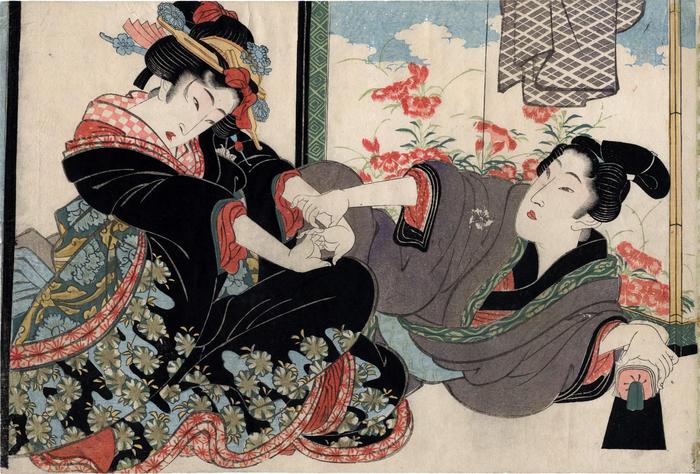Keisai Eisen (渓斎英泉) (artist 1790 – 1848)
Amorous couple before a screen painted with nadeshiko from the series 'Secret Conversations with Courtesans' (Keisei higo - 契情秘語)
1825
15.375 in x 10.125 in (Overall dimensions) Japanese color woodblock print
The National Museum of Asian Art
Philadelphia Museum of Art
San Diego Museum of Art - misidentified as being by Eizan This elegant print is only one of a set of 12, none of which show explicit sexual acts. This type is referred to as an abuna-e.
****
In a WordPress posting from July 1, 2010 Royall Tyler, one of the most credible sources of accurate information on Japanese culture anywhere wrote: "“Gillyflower” and “pink” seem to be the same flower. This was a wonderful discovery, because, in the original, TOKONATSU and NADESHIKO are the same flower, so I needed two different words for the same thing."
[Our notes on what Royall Tyler has said above: According to the Oxford English Dictionary: "The name pink is applied to various species of dianthus with fragrant white, pink, or crimson flowers, including the clove-scented pink called gillyflower. A distinction emerged between carnations, with large, long-stalked flowers, and gillyflowers , the smaller pinks."
A tokonatsu is 常夏.]
****
Michael Watson in his 2021 essay 'Mochizuki: History and Context' noted on page 39 that " The... word nadeshiko literally refers to a flower, the wild pink, but this same word is widely used in premodern Japanese to refer affectionately to a young child." Whether there is a relative point here or not, does not matter. What matters is that the most obscure symbolism shows up in the most unexpected places and should not be dismissed out of hand.
erotic prints (shunga - 春画) (genre)
